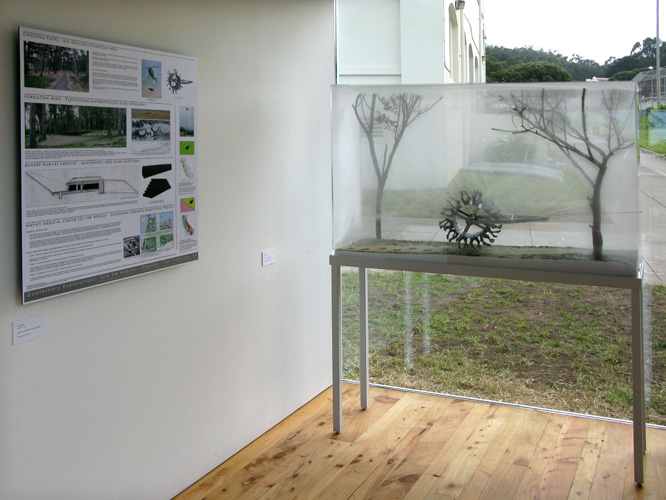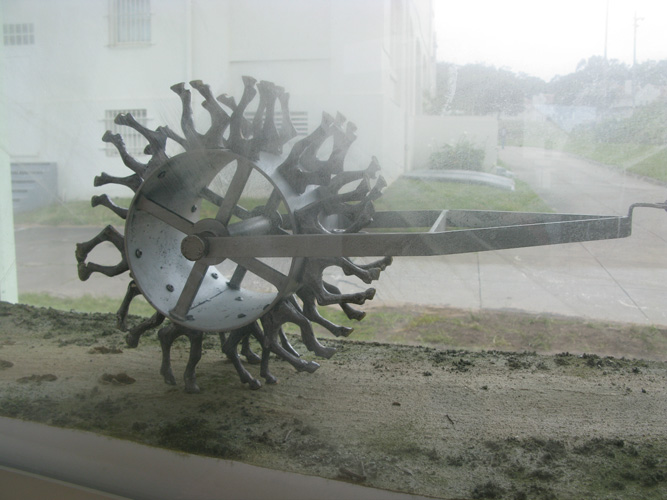 |
||
 |
 |
 |
Proposal: FOR-SITE Foundation Habitat Project - Presidio - San Francisco, CA Below: Proposal text in approximate relatiionship to that in the image above
Return to: Recent Projects |
||
CROSSING PATHS - ELK TRACINGS/PHANTOM HERD CONJURING OF PHANTOM ELK HERD IN PRESIDIO BY NETWORK OF SIMULATED ELK PATHS CROSSING EXISTING PATHS. ELK PATH CREATION OPTIONS 2. Elk hoof apparatus, hoofs spaced for walking browsing or gallop, unit weighted appropriately, pulled along Elk path by winch. Foliage browsed by goats on tethers, elk droppings distributed along paths. Elk hoof apparatus may also be exhibited next to cannon on main parade ground. 3. Small horses with Elk hoof “shoes” walking and browsing from tethers attached to cables running above pathways. |
BUNKER HABITAT ARCHIVE - QUATERNARY SEED BANK MUNITIONS ECOLOGICAL ADAPTATION OF MILITARY SITES/SYSTEMS |
FORGOTTEN WIND - PLEISTOCENE/ANTHROPOCENE DUNE MONUMENT FOREST SAND DUNE - IMAGINARY PLEISTOCENE STRUCTURE ENGAGING ANTHROPOCENE ENVIRONMENT: Carefully placed and shaped semi-barchan sand dune (see detail image to right) in Presidio forest area oriented to prevailing late-Pleistocene wind direction. Sand gathered by one of two strategies: (1) extractions from buried sand dunes throughout western San Francisco peninsula and dredged from continental shelf (Plains of the Farallones, see topo map to right), or (2) carefully extracted from circular “bomb crater” (becomes seasonal pond) on northwestern slope/shore of Presidio. Sand and displaced habitat restored at the end of project. |
Building on Native American concept of medicine as way of knowing and acting in the world - Interspecies landscape becomes hospital becomes university and interspecies think/being-tank of trans-remediation practice and School of Adaptation - Tule Elk (and other species) as teachers, many with direct genetic knowledge and experience of climate, landscape and sea-level change in Bay Area - Pleistocene > Anthropocene genetic remediation courses/interactions/strategies. Alternate placement concept for orientation of species/habitat repatriation area follows nappe structure of Franciscan Complex bedrock/geology. PROJECT: INTER-SPECIES COEQUAL HABITATION/LEARNING EXPLORATIONS - PHASED RETURN TO NATIVE DUNE HABITAT - REPATRIATION OF TULE ELK PHASE I - FORE-SITE Foundation Habitat Project - Construction and Installation of Large Project Study Model PHASE II - Community-based Series of Alternative Inter-species Landscapes/Logics Dialog Using model as point of focus and departure, engagement in an exploratory process for inter-species relationships, non-linear, alternate-verbal learning, adaptive systems, rethinking of institutional structures to include all species and knowledge bases, consideration of political and psychic will to engage in large scale symbolic/synthetic environments that engage paleographic logic and tran-species/ecological landscapes. PHASE III - Site Preparation and Construction of: Wapati Medical Center (of the World). As shown on diagram, central cross area of site allowed to return to later Pleistocene habitat conditions, Tule Elk and other native species repatriated. Anthropocene structures within cross area adapt to trans-Quaternary conditions. Interactive intra-species communication systems, University/Medical analogies further explored. |
PUBLISHED REFERENCES/CREDITS AND TIME SCALE: Arnold, C, 1989, Tule Elk, Carlrhoda Books, Minneapolis. 48 pp. Gaar, G. and Miller, R. W., San Francisco - A Natural History, Arcadia Publishing, Charleston, Chicago, Portsmith, San Francisco. 127 pp. Heizer, R. F. and Elasser, A. B, 1980, The Natural World of the California Indians, University of California Press, Berkeley, Los Angeles, 271 pp. McCullough, D. R. 1969. The Tule Elk: Its History, Behavior, and Ecology. University of California Publication in Zoology, Vol. 88, University of California Press, Berkeley and Los Angeles. 209 pp. Phillips, W. E., 1976, The Conservation of the California Tule Elk, University of Alberta Press. 120 pp. All images by artist unless credited otherwise. Image titles and references clockwise beginning with the upper left project: Elk transport from off-site photo credit: Richard Hewett. Elk hoof apparatus. Image adapted from GGNRA Park Archives & Record Center drawing. Elk dung/native seed munitions: WWII 16” shells/Civil War cannon balls. Left: Roof of Letterman Hospital, WWII; right: hypothetical Presidio map showing area of remediation and Franciscan Complex geologic structure - photo credit - Left: from mural in Thoreau Center, Presidio; right: from GGNRA Presidio website. Top: Barchan dune; center: Tule Elk GG Park 1899; bottom: Hybrid Pleistocene/1895 topo - photo credit -Top: Yann Arthus-Bertrand; Center: Greg Gaar/Ryder Miller; Bottom: adapted from GGNRA Park Archives & Record Center map. Quaternary Period covers the present to 1.8 million years before present and includes: the Anthropocene Epoch as human time, present to about 5,000 years before present in California; Holocene Epoch which overlaps the Anthropocene Epoch, present to 11,000 years before present; and the Pleistocene Epoch, 11,000 to 1,800,000 years before present. Some consider the Holocene Epoch to end at 10,000 or 15,000 years before the present, this exploration uses 11,000 years before present. |
Credits: elk image, Richard Hewett; map, adapted from CA Geologic Survey, Phillips.
|